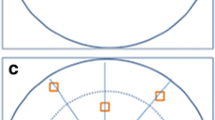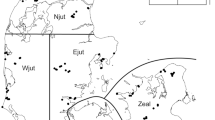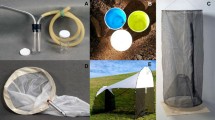Abstract
Practical conservation of biological diversity is dependent on reliable knowledge about what kind, how much, and where the diversity is. To obtain such knowledge three questions, why, what, and how, must be answered before commencing any biodiversity survey. While the questions why and what are often value decisions and thus determined outside the realm of scientific research, the question about how the surveys are conducted lies in the heart of science. Here, we report an intensive repeated survey of wood-inhabiting fungi with the aim of determining the optimal timing and number of the surveys for reliable estimation of the diversity of this species group. The research focusing on the ecology of wood-inhabiting fungi has been increasing but little is known about the reliability of the methods. The variation in the estimates of diversity among surveys was high and the results varied between studied species groups. The site-scale detectability for species belonging to different groups varied from 10 to 95% depending on the survey month and the species group. We conclude that because detectability of many fungi turned out to be poor even when surveys were conducted at an optimal time, the common practice of using a single fruit body survey to estimate fungal diversity of any given area is not enough. We suggest that multiple surveys at an optimal time should be a norm in fungal diversity studies. Improper methodology results in unreliable outcomes that have potential to hamper our goal of conserving the biological diversity.






Similar content being viewed by others
References
Ahti T, Hämet-Ahti L, Jalas J (1968) Vegetation zones and their sections in northwestern Europe. Ann Bot Fenn 5:169–211
Allmér J, Vasiliauskas R, Ihrmark K, Stenlid J, Dahlberg A (2006) Wood-inhabiting fungal communities in woody debris of Norway spruce (Picea abies (L.) Karst.), as reflected by sporocarps, mycelial isolations and T-RFLP identification. FEMS microbiol ecol 55:57–67
Bässler C, Müller J, Dziock F, Brandl R (2010) Effects of resource availability and climate on the diversity of wood-decaying fungi. J Ecol 98:822–832
Berglund H, Edman M, Ericson L (2005) Temporal variation of wood-fungi diversity in boreal old-growth forests: implications for monitoring. Ecol Appl 15:970–982
Boddy L, Jones TH (2008) Interactions between basidiomycota and invertebrates. In: Boddy L, Frankland JC, van West P (eds) Ecology of saprotrophic basidiomycetes. Elsevier, Amsterdam, pp 155–179
Boddy L, Frankland JC, Pv West (eds) (2008) Ecology of saprotrophic basidiomycetes. Elsevier, Amsterdam
Dahlberg A, Mueller GM (2011) Applying IUCN red-listing criteria for assessing and reporting on the conservation status of fungal species. Fungal Ecol 4:147–162
de Boer W, van der Val A (2008) Interactions between saprotrophic basidiomycetes and bacteria. In: Boddy L, Frankland JC, van West P (eds) Ecology of saprotrphic basidiomycetes. Elsevier, Amsterdam, p 143
Egli S, Peter M, Buser C, Stahel W, Ayer F (2006) Mushroom picking does not impair future harvests – results of a long-term study in Switzerland. Biol Conserv 129:271–276
Field SA, Tyre AJ, Possingham HP (2005) Optimizing allocation of monitoring effort under economic and observational constraints. J Wild Manag 69:473–482
Field SA, O’Connor PJ, Tyre AJ, Possingham HP (2007) Making monitoring meaningful. Austral Ecol 32:485–491
Gange AC, Gange EG, Sparks TH, Boddy L (2007) Rapid and recent changes in fungal fruiting patterns. Science 316:71
Garrard GE, Bekessy SA, McCarthy MA, Wintle BA (2008) When have we looked hard enough? A novel method for setting minimum survey effort protocols for flora surveys. Austral Ecol 33:986–998
Halme P, Kotiaho JS, Ylisirniö AL, Hottola J, Junninen K, Kouki J, Lindgren M, Mönkkönen M, Penttilä R, Renvall P, Siitonen J, Similä M (2009) Perennial polypores as indicators of annual and red-listed polypores. Ecol Indic 9:256–266
Hansen L, Knudsen H (1997) Nordic macromycetes vol 3, heterobasidioid, aphyllophoroid and gastromycetoid basidiomycetes. Nordsvamp, Copenhagen
Hansen L, Knudsen H (2000) Nordic macromycetes vol 1 ascomycetes. Nordsvamp, Copenhagen
Heilmann-Clausen J, Christensen M (2003) Fungal diversity on decaying beech logs – implications for sustainable forestry. Biodivers Conserv 12:953–973
Heilmann-Clausen J, Christensen M (2005) Wood-inhabiting macrofungi in Danish beech-forests–conflicting diversity patterns and their implications in a conservation perspective. Biol Conserv 122:633–642
Jönsson MT, Edman M, Jonsson BG (2008) Colonization and extinction patterns of wood-decaying fungi in a boreal old-growth Picea abies forest. J Ecol 96:1065–1075
Junninen K, Komonen A (2011) Conservation ecology of boreal polypores: a review. Biol Conserv 144:11–20
Juutilainen K, Halme P, Kotiranta H, Mönkkönen M (2011) Size matters in studies of dead wood and wood-inhabiting fungi. Fungal Ecol 4:342–349
Kauserud H, Stige LC, Vik JO, Okland RH, Høiland K, Stenseth NC (2008) Mushroom fruiting and climate change. PNAS 105:3811–3814
Kauserud H, Heegaard E, Semenov MA, Boddy L, Halvorsen R, Stige LC, Sparks TH, Gange AC, Stenseth NC (2010) Climate change and spring-fruiting fungi. Proc R Soc B 277:1169–1177
Kery M, Spillmann JH, Truong C, Holderegger R (2006) How biased are estimates of extinction probability in revisitation studies? J Ecol 94:980–986
Kleijn D, Baquero R, Clough Y, Diaz M, Esteban J, Fernandez F, Gabriel D, Herzog F, Holzschuh A, Jöhl R, Knop E, Kruess A, Marshall EJ, Steffan-Dewenter I, Tscharntke T, Verhulst J, West TM, Yela JL (2006) Mixed biodiversity benefits of agri-environment schemes in five European countries. Ecol Lett 9:243–254
Kotiranta H, Saarenoksa R, Kytövuori I (2009) Aphyllophoroid fungi of Finland. A check-list with ecology, distribution and threat categories. Norrlinia 19:1–223
Kull T, Sammul M, Kull K, Lanno K, Tali K, Gruber B, Schmeller D, Henle K (2008) Necessity and reality of monitoring threatened European vascular plants. Biodivers Conserv 17:3383–3402
Kytövuori I, Nummela-Salo U, Ohenoja E, Salo P, Vauras J (2005) Helttasienten ja tattien ekologiataulukko. Ecology table of agarics and boletes in Finland. Suomen helttasienten ja tattien ekologia, levinneisyys ja uhanalaisuus (eds P. Salo, T. Niemelä, U. Nummela-Salo & E. Ohenoja), pp 228–426. Edita, Helsinki
Legg CJ, Nagy L (2006) Why most conservation monitoring is, but need not be, a waste of time. J Env Manag 78:194–199
Lengyel S, Kobler A, Kutnar L, Framstad E, Henry P, Babij V, Gruber B, Schmeller D, Henle K (2008) A review and a framework for the integration of biodiversity monitoring at the habitat level. Biodivers Conserv 17:3341–3356
Lodge DJ, Ammirati JF, O`Dell TE, Mueller GM (2004) Collecting and describing macrofungi. In: Mueller GM, Bills GF, Foster MS (eds) Biodiversity of fungi. Inventory and monitoring methods. Elsevier, London, pp 128–158
Lõhmus A (2009) Factors of species-specific detectability in conservation assessments of poorly studied taxa: the case of polypore fungi. Biol Conserv 142:2792–2796
Mackenzie DI, Royle JA (2005) Designing occupancy studies: general advice and allocating survey effort. J Appl Ecol 42:1105–1114
MacKenzie DI, Nichols JD, Royle JA, Pollock KH, Bailey LL, Hines JE (2006) Occupancy estimation and modeling: inferring patterns and dynamics of species occurrence. Elsevier, San Diego
Mönkkönen M, Ylisirniö A, Hämäläinen T (2009) Ecological efficiency of voluntary conservation of boreal-forest biodiversity. Conserv Biol 23:339–347
Mueller GM, Schmit JP (2007) Fungal biodiversity: what do we know? what can we predict? Biodivers Conserv 16:1–5
Mueller GM, Bills GF, Foster MS (eds) (2004) Biodiversity of fungi: inventory and monitoring methods. Elsevier, London
Mueller GM, Schmit JP, Leacock PR, Buyck B, Cifuentes J, Desjardin DE et al (2007) Global diversity and distribution of macrofungi. Biodivers Conserv 16:37–48
Müller J, Engel H, Blaschke M (2007) Assemblages of wood-inhabiting fungi related to silvicultural management intensity in beech forests in southern Germany. Eur J For Res 126:513–527
Norstedt G, Bader P, Ericson L (2001) Polypores as indicators of conservation value in Corsican pine forests. Biol Conserv 99:347–354
Ovaskainen O, Nokso-Koivisto J, Hottola J, Rajala T, Pennanen T, Ali-Kovero H, Miettinen O, Oinonen P, Auvinen P, Paulin L, Larsson KH, Mäkipää R (2010) Identifying wood-inhabiting fungi with 454 sequencing–what is the probability that BLAST gives the correct species? Fungal Ecol 3:274–283
Parker-Rhodes AF (1955) Statistical aspects of fungus forays. Trans Brit Mycol Soc 38:283–290
Possingham HP, Grantham H, Rondinini C (2007) How can you conserve species haven’t been found? J Biogeogr 34:758–759
Pouska V, Svoboda M, Lepšová A (2010) The diversity of wood-decaying fungi in relation to changing site conditions in an old-growth mountain spruce forest, central Europe. Eur J For Res 129:219–231
Rhodes JR, Tyre AJ, Jonzen N, McAlpine CA, Possingham HP (2006) Optimizing presence-absence surveys for detecting population trends. J Wild Manag 70:8–18
Sastre P, Lobo JM (2009) Taxonomist survey biases and the unveiling of biodiversity patterns. Biol Conserv 142:462–467
Schigel DS, Niemelä T, Kinnunen J (2006) Polypores of western Finnish Lapland and seasonal dynamics of polypore beetles. Karstenia 46:37–64
Schmit JP (2005) Species richness of tropical wood-inhabiting macrofungi provides support for species-energy theory. Mycologia 97:751–761
Schmit JP, Murphy JF, Mueller GM (1999) Macrofungal diversity of a temperate oak forest: a test of species richness estimators. Can J Bot 77:1014–1027
Straatsma G, Ayer F, Egli S (2001) Species richness, abundance, and phenology of fungal fruit bodies over 21 years in a swiss forest plot. Mycol Res 105:515–523
Vasiliauskas R, Vasiliauskas A, Stenlid J, Matelis A (2004) Dead trees and protected polypores in unmanaged north-temperate forest stands of Lithuania. For Ecol Manag 193:355–370
Yoccoz NG, Nichols JD, Boulinier T (2001) Monitoring of biological diversity in space and time. Tree 16:446–453
Acknowledgments
Panu Kunttu was importantly involved in the planning of this study. We thank Atte Komonen, Asko Lõhmus, Jacob Heilmann-Clausen, Jari Kouki, Claudia Perini, an anonymous reviewer and the “Journal club” members for constructive comments on the manuscript. Especially Noora Vartija but also Sini Eräjää, Katja Juutilainen, Emmi Lehkonen, Anni Markkanen, Anna Mäkelä, Kristiina Nyholm, and Katriina Peltonen assisted in the field work. Heikki Kotiranta, Seppo Huhtinen, Tuomo Niemelä, Lasse Kosonen, Unto Söderholm, Tea von Bonsdorff, Ilkka Kytövuori, Matti Kulju, Anni Markkanen and Katja Juutilainen all identified some difficult samples and were thus of priceless help during the work. This research was funded by Koneen säätiö foundation and the Centre of Excellence in Evolutionary Research.
Author information
Authors and Affiliations
Corresponding author
Electronic supplementary material
Below is the link to the electronic supplementary material.
Rights and permissions
About this article
Cite this article
Halme, P., Kotiaho, J.S. The importance of timing and number of surveys in fungal biodiversity research. Biodivers Conserv 21, 205–219 (2012). https://doi.org/10.1007/s10531-011-0176-z
Received:
Accepted:
Published:
Issue Date:
DOI: https://doi.org/10.1007/s10531-011-0176-z




